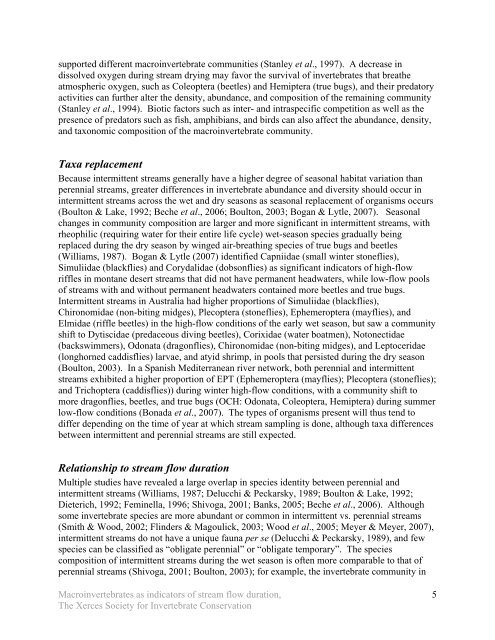Using Aquatic Macroinvertebrates as Indicators of Stream Flow ...
Using Aquatic Macroinvertebrates as Indicators of Stream Flow ...
Using Aquatic Macroinvertebrates as Indicators of Stream Flow ...
Create successful ePaper yourself
Turn your PDF publications into a flip-book with our unique Google optimized e-Paper software.
supported different macroinvertebrate communities (Stanley et al., 1997). A decre<strong>as</strong>e indissolved oxygen during stream drying may favor the survival <strong>of</strong> invertebrates that breatheatmospheric oxygen, such <strong>as</strong> Coleoptera (beetles) and Hemiptera (true bugs), and their predatoryactivities can further alter the density, abundance, and composition <strong>of</strong> the remaining community(Stanley et al., 1994). Biotic factors such <strong>as</strong> inter- and intr<strong>as</strong>pecific competition <strong>as</strong> well <strong>as</strong> thepresence <strong>of</strong> predators such <strong>as</strong> fish, amphibians, and birds can also affect the abundance, density,and taxonomic composition <strong>of</strong> the macroinvertebrate community.Taxa replacementBecause intermittent streams generally have a higher degree <strong>of</strong> se<strong>as</strong>onal habitat variation thanperennial streams, greater differences in invertebrate abundance and diversity should occur inintermittent streams across the wet and dry se<strong>as</strong>ons <strong>as</strong> se<strong>as</strong>onal replacement <strong>of</strong> organisms occurs(Boulton & Lake, 1992; Beche et al., 2006; Boulton, 2003; Bogan & Lytle, 2007). Se<strong>as</strong>onalchanges in community composition are larger and more significant in intermittent streams, withrheophilic (requiring water for their entire life cycle) wet-se<strong>as</strong>on species gradually beingreplaced during the dry se<strong>as</strong>on by winged air-breathing species <strong>of</strong> true bugs and beetles(Williams, 1987). Bogan & Lytle (2007) identified Capniidae (small winter stoneflies),Simuliidae (blackflies) and Corydalidae (dobsonflies) <strong>as</strong> significant indicators <strong>of</strong> high-flowriffles in montane desert streams that did not have permanent headwaters, while low-flow pools<strong>of</strong> streams with and without permanent headwaters contained more beetles and true bugs.Intermittent streams in Australia had higher proportions <strong>of</strong> Simuliidae (blackflies),Chironomidae (non-biting midges), Plecoptera (stoneflies), Ephemeroptera (mayflies), andElmidae (riffle beetles) in the high-flow conditions <strong>of</strong> the early wet se<strong>as</strong>on, but saw a communityshift to Dytiscidae (predaceous diving beetles), Corixidae (water boatmen), Notonectidae(backswimmers), Odonata (dragonflies), Chironomidae (non-biting midges), and Leptoceridae(longhorned caddisflies) larvae, and atyid shrimp, in pools that persisted during the dry se<strong>as</strong>on(Boulton, 2003). In a Spanish Mediterranean river network, both perennial and intermittentstreams exhibited a higher proportion <strong>of</strong> EPT (Ephemeroptera (mayflies); Plecoptera (stoneflies);and Trichoptera (caddisflies)) during winter high-flow conditions, with a community shift tomore dragonflies, beetles, and true bugs (OCH: Odonata, Coleoptera, Hemiptera) during summerlow-flow conditions (Bonada et al., 2007). The types <strong>of</strong> organisms present will thus tend todiffer depending on the time <strong>of</strong> year at which stream sampling is done, although taxa differencesbetween intermittent and perennial streams are still expected.Relationship to stream flow durationMultiple studies have revealed a large overlap in species identity between perennial andintermittent streams (Williams, 1987; Delucchi & Peckarsky, 1989; Boulton & Lake, 1992;Dieterich, 1992; Feminella, 1996; Shivoga, 2001; Banks, 2005; Beche et al., 2006). Althoughsome invertebrate species are more abundant or common in intermittent vs. perennial streams(Smith & Wood, 2002; Flinders & Magoulick, 2003; Wood et al., 2005; Meyer & Meyer, 2007),intermittent streams do not have a unique fauna per se (Delucchi & Peckarsky, 1989), and fewspecies can be cl<strong>as</strong>sified <strong>as</strong> “obligate perennial” or “obligate temporary”. The speciescomposition <strong>of</strong> intermittent streams during the wet se<strong>as</strong>on is <strong>of</strong>ten more comparable to that <strong>of</strong>perennial streams (Shivoga, 2001; Boulton, 2003); for example, the invertebrate community in<strong>Macroinvertebrates</strong> <strong>as</strong> indicators <strong>of</strong> stream flow duration,The Xerces Society for Invertebrate Conservation5
















